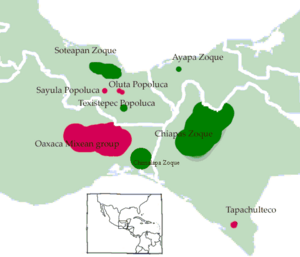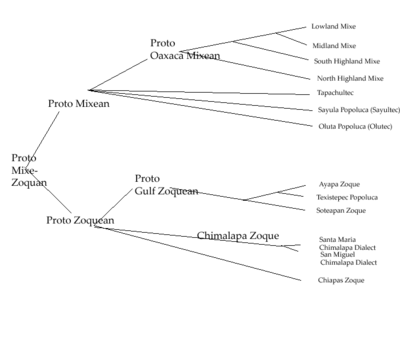Mixe–Zoque languages facts for kids
Quick facts for kids Mixe–Zoque |
|
|---|---|
| Mije–Soke | |
| Geographic distribution: |
Mesoamerica: Mexico Oaxaca, Chiapas, Tabasco, Veracruz |
| Linguistic classification: | Totozoquean ?
|
| Proto-language: | Proto-Mixe–Zoquean |
| Subdivisions: |
Mixean
Zoquean
|
 Locations where the Mixe–Zoque languages are spoken: Mixe (red) and Zoque (green)
|
|
The Mixe–Zoque (pronounced mee-hay-SOH-kay) languages are a group of languages spoken mainly in Mexico. You can find most of these languages in the area around the Isthmus of Tehuantepec.
The Mexican government officially recognizes three main types of Mixe–Zoque languages. These are Mixe (also called ayook), with about 188,000 speakers. Then there's Zoque (or o'de püt), with about 88,000 speakers. Finally, there are the Popoluca languages, some of which are Mixean and some Zoquean, with about 69,000 speakers.
However, there are many different versions of these languages. Some experts count 17 different languages in this family. Others, like Søren Wichmann, count 12 languages and 11 dialects. One language that used to be part of this family, Tapachultec, is now extinct. It was once spoken in Tapachula, in Chiapas.
Contents
History of Mixe–Zoque Languages
Long ago, the Mixe–Zoque language family might have been spoken in a much wider area. This could have included the Pacific coast of Guatemala.
Some experts, like Terrence Kaufman and Lyle Campbell, believe that the ancient Olmec people spoke a Mixe–Zoque language. The Olmecs were one of the earliest major cultures in Mesoamerica. This idea comes from many words that seem to have been borrowed from Mixe–Zoque into other Mesoamerican languages.
Kaufman and John Justeson also think they have figured out some writings from the Isthmian script. This script is sometimes called 'Epi-Olmec'. They believe these writings, like those on La Mojarra Stela 1, are in an old Mixe–Zoquean language.
However, not everyone agrees with these ideas. Some scholars, like Michael D. Coe and David Stuart, say there aren't enough examples of Isthmian writing to be sure. They tried to use Kaufman's ideas on other writings, but it didn't work well.
Another expert, Wichmann, pointed out that some borrowed words were only from Zoque, not from both Mixe and Zoque. This would mean the borrowing happened later than the time of the Olmec culture. But later research suggests the Mixe and Zoque languages split apart much earlier, making this argument less strong.
Later, Kaufman (in 2001) suggested that Mixe–Zoque languages were present in the ancient city of Teotihuacan. He thought they played an important role in spreading certain language features across the Mesoamerican Linguistic Area.
Connections to Other Language Families
Linguists sometimes try to group language families together. The Mixe–Zoque languages have been suggested to be part of bigger groups. For example, some thought they might be related to Mayan languages or Totonacan languages. While some of these ideas have been debated, experts continue to look for connections between Mixe–Zoque and other language groups.
How Mixe–Zoque Languages Are Grouped
Linguists classify languages to understand how they are related. Here's one way the Mixe–Zoque languages are grouped by Søren Wichmann (1995).
- Proto-Mixe-Zoquean (The original language that Mixe-Zoque languages came from)
- Proto-Mixean
- Tapachultec
- Sayula Popoluca (also called Sayultec)
- Oluta Popoluca (also called Olutec)
- Proto-Oaxaca Mixean
- North Highland Mixe
- South Highland Mixe
- Midland Mixe, Lowland Mixe
- Proto-Zoquean
- Proto-Gulf Zoquean
- Chimalapa Zoque
- Chiapas Zoque
Another way to classify these languages was proposed by Kaufman & Justeson (2000). This classification also shows the main branches of Mixe and Zoque.
How Words Are Built
Mixe–Zoque languages have complex verbs. This means that a single verb can carry a lot of information. They often show who is doing the action and who the action is being done to.
These languages also have different ways to show when an action happens. For example, they have ways to show if something is still happening, if it's finished, or if it's going to happen.
Mixe–Zoque Languages Today
Ethnologue is a website that lists languages around the world. It uses an older way of classifying Mixe–Zoque languages. This classification is based on how well speakers of different languages can understand each other.
Here are some of the main Mixe and Zoque languages and how many people speak them:
- Mixe languages — about 90,000 native speakers
- Eastern Mixe — around 72,000 speakers. This includes dialects like Coatlán, Istmo, Quetzaltepec, Juquila, and Mazatlán.
- Veracruz Mixe — around 4,000 speakers. This includes dialects like Oluta (which has very few speakers left) and Sayula.
- Western Mixe — around 10,000 speakers. This includes dialects like Totontepec and Tlahuitoltepec.
- Zoque languages — about 60,000 native speakers
- Chiapas Zoque — around 22,000 speakers. This includes dialects like Copainalá, Rayón, and Francisco León.
- Oaxaca Zoque – around 4,500 speakers. This includes the Chimalapa dialect.
- Veracruz Zoque — around 30,000 speakers. This includes dialects like Highland and Texistepec (which also has very few speakers left).
See also



